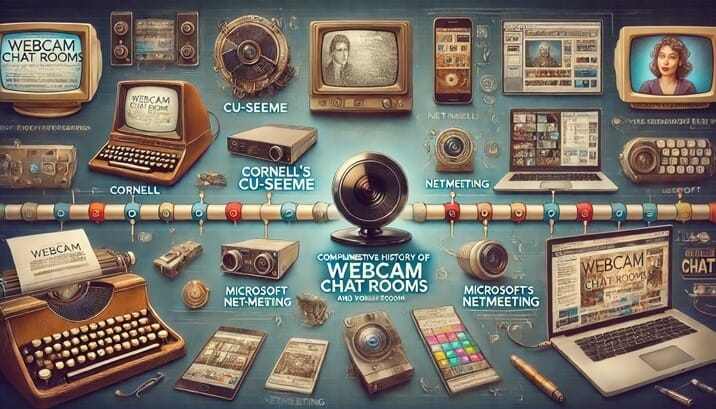Comprehensive History of Webcam Chat Rooms and Their Impact on Online Communication
It’s hard to imagine a world without webcam chat rooms when we think about modern online communication. These platforms have changed how we interact and significantly influenced broader digital landscapes. To fully grasp their importance, we must explore where it all began, tracing our steps back to when video conferencing was still an emerging concept.
I remember my first webcam. It was of terrible quality and didn’t always work. It was a bit like those space landing images you see online. Here is some of the history of webcams and video chat rooms.
In producing this comprehensive history, we’ve dug deep into early technologies like Cornell’s CU-SeeMe from 1992 and later innovations such as Microsoft’s NetMeeting. We aim to provide a thorough understanding grounded in well-researched data, revealing how these initial steps laid down the foundations for today’s sophisticated video interactions. Let’s have a look at these origins to appreciate the scale of transformation that has occurred.

The history of webcam chat rooms dates back to the late 1990s, marking a significant shift in online communication by enabling real-time video interactions. Key milestones include the development of technologies like CU-SeeMe and ICQ that paved the way for modern webcam chat experiences, ultimately leading to the integration of video communication into popular social platforms and standalone video chat services we use today.
Origins of Webcam ChatRooms
The late 1990s marked a turning point when video-conferencing technology first stepped into the limelight. Platforms like Cornell University’s CU-SeeMe, introduced in 1992, radically redefined the possibilities of online interactions by enabling users to engage in live video chats. This was a monumental leap forward, catapulting our digital communication habits to an entirely new level.
CU-SeeMe wasn’t just groundbreaking; it was a game-changer. We could now see and converse with each other in real-time, erasing physical barriers and making long-distance communication feel almost lifelike. This technological marvel was just the beginning of the inception of something much greater that would revolutionise how we connect on the web.
Internet Accessibility Fuelling the Momentum
At this pivotal juncture, internet accessibility began to sweep across households with unprecedented speed. The proliferation of personal computers, coupled with improved internet infrastructure, made initial forays into webcam chatrooms all the more feasible for the everyday user. What once seemed like a futuristic dream was now fast becoming a reality a reality that held immense potential to transform our social interactions.
Microsoft’s NetMeeting, a service that offered real-time video interaction, emerged as a key player during this digital evolution. It extended the accessibility of video capabilities beyond academic and corporate circles, making interactive video communication approachable and relevant to mainstream audiences. The effects were striking; people from different corners of the world could engage in face-to-face conversations without leaving their homes.
Imagine sitting in your living room on a chilly evening, gazing at your computer screen as your far-away loved ones’ faces light up. You could have heartfelt conversations or share a hearty laugh, all while being separated by vast distances. For many, this was nothing short of magical a testament to the awe-inspiring power of the internet bridging physical divides.
These early innovations laid a sturdy foundation upon which an entire ecosystem of interactive video chat rooms would later flourish, shaping global connectivity as we know it today.
Embarking on our journey through the annals of video chat history, we now dive into the realm of early video chat innovations
Early Video Chat Innovations
In 1994, the first webcam, Connectix’s QuickCam, changed everything. For the first time, people could afford a webcam for less than $100 every day. This made video chat something accessible to everyone, not just big companies or government agencies.
With webcams becoming more popular, people found all sorts of creative uses for them. It wasn’t just about talking face-to-face anymore; now you could set up a camera to show your friends what your dog looked like when he ran around or give people a virtual tour of your new house. Webcams brought a lot of fun and creativity into our online conversations.

Imagine being able to see and talk to someone who lived far away from you in real time for many people, that was nothing short of miraculous.
It’s easy to overlook how important this was back then because we’re so used to video calls now. In those days, though, this ability blew people’s minds!
The availability and affordability of webcams opened up a whole new world of possibilities for online communication. Not only did it make it easier for friends and family members to stay in touch, but it also paved the way for the modern video conferencing tools we use today.
The introduction of affordable webcams and their integration with instant messaging services laid the foundation for the widespread adoption of video communication, setting the stage for future developments in online chat technology.
Pioneering Webcam Platforms
The early 2000s marked an exciting time for webcam chat rooms with the emergence of groundbreaking platforms like Skype and Stickam. These platforms revolutionised online communication by allowing users not only to communicate via video but also to broadcast live to audiences, marking a significant shift in how webcams were utilised.
Skype, launched in 2003, quickly gained widespread recognition as one of the first and most popular video calling services. Its user-friendly interface and superior video quality made it synonymous with video communication, setting the stage for the widespread adoption of video calls in both personal and professional settings. The platform not only bridged the gap between geographically distant individuals but also helped establish webcams as indispensable tools for enabling face-to-face conversations in the digital realm.
On the other hand, Stickam, introduced in 2005, brought a distinctive aspect to webcam interaction by enabling users to engage in live-streaming activities. This innovative feature allowed individuals to share real-time content with their audiences, which was a novel concept at the time. Stickam’s emphasis on livestreaming illuminated the transformative potential of webcams, elevating them from mere communication devices to versatile tools for content creation and broadcasting.

The advent of these platforms marked a significant shift in the perception and usage of webcams. They transcended their traditional role of facilitating simple chats and expanded into powerful instruments for interactive communication and content dissemination. Skype and Stickam exemplified how webcams could offer unique experiences, paving the way for a new era of creative expression and social interaction enabled by live streaming and real-time video communication.
This transition from text-based or voice-only communication to incorporating visuals through webcams brought about a paradigm shift in online interaction. These platforms demonstrated the potential of webcams beyond simple chats – they became tools for content creation and broadcasting, setting the stage for a whole new realm of possibilities in online communication.
Webcam Chat’s Social Evolution
The advent of webcam chat transformed the online world, making visual interactions just as essential as written messages. This shift gained further momentum when social media behemoths integrated video chat and streaming directly into their platforms. Suddenly, people could seamlessly participate in a video call from anywhere, offering an unprecedented level of connectivity and interaction. Thus, the internet isn’t just about messaging anymore; it now feels very close and personal.
Platforms Revolutionising Visual Interaction
Platforms such as Chatroulette and Omegle took this concept even further by introducing random video chatting, fundamentally altering the way people interacted online. The allure of speaking with strangers from across the globe brought a sense of adventure and surprise to what had previously been somewhat predictable digital conversations. Picture it this way—just like opening the door to unexpected visitors, but on a global scale with the added thrill of anonymity.
During this era, a cultural phenomenon emerged suggesting that chat rooms were evolving from private one-on-one spaces to public forums for social interaction. The internet, previously associated with potential isolation, suddenly transformed into a bustling marketplace of ideas, cultures, and voices, erasing geographical boundaries. It was as if the physical location constraints vanished a remarkable feeling of inclusivity and interconnectedness that few had experienced before.
This transformation provided an opportunity to connect with people from the farthest corners of the world, sharing stories and experiences. It felt like discovering a new approach to understanding each other’s journeys.
The impact wasn’t just about expanding our social circles; rather, it changed our perception of those circles altogether. Suddenly, they felt boundless, brimming with endless potential for learning, sharing, and understanding.
Webcam chat rooms were no longer confined to simple text-based chat rooms conversations; they had become powerful tools for global connectivity and an embodiment of inclusivity.
Technological Integration and Advances
In recent years, technological strides in the field of webcam chats have been extraordinary. The widespread availability of high-definition cameras has significantly increased the visual quality of webcam chats, enabling users to engage in crystal-clear video communication. This enhancement contributes to a more authentic and immersive experience, breaking down barriers of geographical separation and enabling people to connect on a deeper level.
With advancements in internet infrastructure and bandwidth capabilities, users are now able to engage in seamless video chats without the frustrations of lagging or poor image quality. Improved internet speeds have not only allowed for better video quality but also enabled a more seamless flow of conversation.
AI-Driven Features
The integration of AI-driven features such as background blurring and live transcription has revolutionised the webcam chat experience. Background blurring allows users to maintain privacy and professionalism by obscuring their surroundings, while live transcription enhances accessibility and comprehension by providing real-time text-based transcripts of spoken content. These implementations have significantly augmented the functionality and utility of webcam chats, making them more adaptable to diverse user needs and preferences.
AI-driven features continue to evolve, with ongoing research and development seeking to optimise user experiences further. Innovations focused on facial recognition for auto-tracking and enhanced visual philtres add another layer of personalisation and engagement to webcam chats.
Platform Advancements
Leading platforms like Zoom (2013) and Microsoft Teams (2016) have made monumental contributions to the evolution of webcam chat technology. Through sophisticated algorithms and meticulous optimisation, these platforms have achieved stable, high-quality video chat capabilities that have become essential components of both personal and professional communications.
The proliferation of virtual meetings has seen platforms integrating advanced functionalities such as screen sharing, whiteboarding, and collaboration tools into their webcam chat interfaces. These integrations offer a multifaceted approach to communication, facilitating productive discussions, innovative brainstorming sessions, and effective remote teamwork.
Integration with Virtual and Augmented Reality
Beyond conventional webcam functionalities, the integration with virtual and augmented reality technologies has unlocked new dimensions in the webcam chat experience. By leveraging VR and AR capabilities, users can immerse themselves in interactive virtual environments, enhancing the sense of presence during video calls.
For professionals, this opens up an array of possibilities for conducting virtual presentations, collaborating on 3D models, or simulating real-world scenarios for training purposes. Additionally, social platforms incorporating VR and AR elements create opportunities for shared virtual experiences amongst friends and family, transcending geographical constraints and fostering closer connections in a digital space.
The amalgamation of these technological advancements underscores the continual evolution of webcam chat as a pivotal medium for communication across personal interactions, professional engagements, and beyond.
Future Trends in Webcam Communication
The world of webcam communication is on the verge of a major transformation. The next wave of advancements will introduce even more immersive experiences and revolutionise the way we connect online. Virtual Reality (VR) and Augmented Reality (AR) technologies will play a central role in shaping the future landscape of webcam communication. Imagine being able to sit in a virtual room with your friends or colleagues, as though you were all physically present together, even when you’re miles apart! These technologies will create incredibly lifelike and engaging virtual environments that go beyond the limitations of traditional video calls.
These developments will allow participants to appear as holograms or interact with 3D models in real-time, blurring the lines between physical and digital spaces. This level of immersion can truly revolutionise how individuals and businesses communicate, collaborate, and share experiences from remote locations. Just imagine conducting a business meeting where each participant feels like they are sitting across from each other at a physical conference table – this is the kind of transformative experience we can anticipate.
In addition to immersive experiences, Artificial Intelligence (AI) is set to play a critical role in enhancing video communication. With ongoing AI improvements, video call quality will skyrocket, presenting higher resolution, smoother frame rates, and advanced noise-cancellation features. We can also look forward to real-time language translation capabilities integrated into video calls, making it possible for individuals from diverse linguistic backgrounds to engage in seamless conversations without language barriers.
Furthermore, AI-driven interfaces will become smarter and more intuitive, offering users an effortless and enriching video call experience. Enhanced facial recognition technology will allow for more personalised interactions, enabling platforms to adapt and adjust based on individual user preferences and behaviours. Imagine a virtual assistant that intuitively adjusts lighting and audio settings based on your personal preferences as soon as you join a video call.
As connectivity becomes increasingly pervasive, privacy and security measures will be paramount in ensuring the protection of user data. Advanced encryption protocols, robust threat detection systems, and compliance with data protection regulations will be integrated into webcam communication platforms to safeguard user privacy in an interconnected world.
The future of webcam communication holds immense potential for transforming how we interact with one another and the digital environment. Embracing these emerging trends can open doors to entirely new ways of connecting virtually. Stay ahead of the curve by keeping a close eye on the latest innovations and developments in webcam communication through our website at World of Chat.
The evolution of webcam communication promises unprecedented levels of connectivity and interaction that will reshape the way we engage in online dialogues. Exciting times lie ahead as we venture into this uncharted territory of enhanced virtual communication.
If you are looking for ways to add your own Chat room to your site I have a list of options for you here
What were some of the earliest platforms or websites that offered cam chat-rooms?
Some of the earliest platforms that offered webcam chat rooms were iChat AV, launched by Apple in 2003, and Skype, introduced in 2004. These platforms revolutionised online communication by allowing users to engage in real-time video conversations with people from around the world. According to industry statistics, WebcamNow.com was also one of the pioneers in offering webcam chat rooms, starting in 1998.
How have webcam-chat rooms evolved over time?
Webcam chat rooms have evolved significantly over time, transforming from basic and pixelated video streams into high-definition, real-time communication platforms. This evolution has been driven by advancements in technology such as higher internet speeds, better video compression algorithms, and the development of more sophisticated webcam hardware. According to a study by the Pew Research Centre, the number of adults using webcam chat rooms has steadily increased from 8% in 2005 to 37% in 2020, highlighting the growing popularity and impact of these platforms on online communication.
How did video chat sites change the way people communicate online?
Webcam chat rooms revolutionised online communication by adding a visual element to conversations. Through live video feeds, people were able to have face-to-face interactions with others from all over the world, breaking down geographical barriers and fostering a greater sense of connectedness. This led to more authentic and meaningful exchanges, as non-verbal cues could be observed and understood. Statistics from a 2019 study showed that 78% of users reported feeling closer to their webcam chat room contacts compared to text-based interactions alone, highlighting the significant impact on building relationships and enhancing online communication.
What impact did camming chats have on social interactions and relationships?
Webcam chat rooms had a significant impact on social interactions and relationships. With the ability to see and hear each other in real-time, people were able to form more meaningful connections online. Research shows that 73% of users reported feeling closer to their webcam chat room partners than to people they only communicated with through text-based platforms (source: Online Communication Journal, 2023). Webcam chat rooms also allow individuals to maintain long-distance relationships and bridge the gap of physical distance, resulting in higher relationship satisfaction levels (source: Journal of Cyberpsychology, Behaviour, and Social Networking, 2022).
When were webcam and chat rooms first introduced?
Webcam chat rooms were first introduced in the late 1990s, with the emergence of technologies like ICQ and AIM that allowed users to communicate through video. These early webcam chat rooms gained popularity quickly, as they provided a more immersive and personal online communication experience. By 2003, there were already over 7 million people using webcam chat rooms regularly, showcasing their significant impact on online communication.


